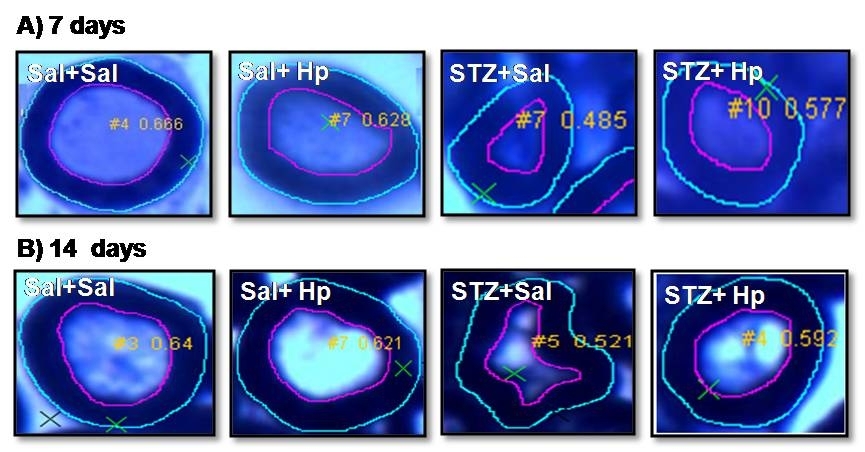

Treatment with the peptide hemopressin helped regenerate myelin sheath in mice with diabetic peripheral neuropathy
The peptide hemopressin inhibits pain and assists recovery of peripheral nerves in mice.
The peptide hemopressin inhibits pain and assists recovery of peripheral nerves in mice.

Treatment with the peptide hemopressin helped regenerate myelin sheath in mice with diabetic peripheral neuropathy
By Karina Toledo, in Foz do Iguaçu (Paraná) | Agência FAPESP – Hemopressin, a peptide naturally found in humans and other mammals, has proved to be a promising alternative for the treatment of diabetic peripheral neuropathy in experiments with mice conducted at the University of São Paulo’s Biomedical Science Institute (ICB-USP) in Brazil.
Initial results of the research project, carried out with support from FAPESP, were presented on August 30 during the 31st Annual Meeting of the Federation of Experimental Biology Societies (FeSBE), held at Foz do Iguaçu, Paraná State, Brazil.
“In addition to eliminating the animals’ pain, the treatment promoted partial regeneration of the myelin sheath that forms a protective layer around neurons and acts as an electrical insulator, facilitating impulse conduction in axons,” said Camila Squarzoni Dale, a professor in ICB-USP’s Anatomy Department and principal investigator for the study.
Diabetic peripheral neuropathy, she explained, is one of the most common chronic and incapacitating complications of diabetes. When the disease is not adequately controlled, excessive levels of blood sugar cause oxidation of the myelin sheath and damage the structure of the peripheral nerves. This degenerative process is not only painful but also jeopardizes communication among neurons and can lead to the need for lower limb or extremity amputation.
Approximately 50% of diabetics are estimated to suffer from peripheral neuropathy, and no treatment is currently available to reverse the condition. Physicians can offer only palliative care for pain management.
Analgesic potential
Dale’s group decided to test the analgesic potential of hemopressin in animals after observing that the peptide’s chemical structure is similar to that of substances classified as opioids, such as morphine, which are already widely used to combat pain.
Hemopressin was first described in 2013 by Emer Ferro, a researcher at ICB-USP who isolated it from the brains of mice. Since then, several groups have investigated its biological effects.
In humans, hemopressin is part of the polypeptide chain that forms hemoglobin, the protein that makes blood red and transports oxygen from the lungs to the body's organs and tissues. In previous studies performed at ICB-USP, Dale showed that hemopressin binds to cannabinoid CB-1 receptors, which are expressed primarily in the cells of the central nervous system.
In their most recent experiments, the researchers used laboratory-synthesized peptides identical to those found in nature and administered them orally to mice.
To induce a condition similar to type 1 diabetes in healthy mice, they injected streptozotocin (STZ), a chemical that destroys the insulin-producing beta cells of the pancreas. Approximately 14 days later, the animals already exhibited symptoms of neuropathy.
Pain threshold was measured by the von Frey test, which uses nylon filaments of varying thicknesses to poke the animal’s hind paw.
“Each filament represents a force in grams,” Dale explained. “We start with one as thin as a human hair, which in healthy animals doesn’t induce pain, and end with one about as thick as a ballpoint pen refill.”
Healthy animals display discomfort only when pressure exceeds 1 g, whereas in Dale’s experiments the mice with neuropathy tolerated 0.2 g at most.
“After treatment with hemopressin, however, the diabetic mice responded just like healthy mice, displaying signs of pain only when pressure reached 1 g,” Dale said.
Histological analysis of the peripheral nerves showed that diabetes caused a 30% reduction in the myelin of the mice that had received the STZ injection. In the group treated with hemopressin, 50% of the myelin that had been lost was recovered.
The researchers at ICB-USP do not yet have a detailed picture of the mechanisms through which hemopressin promoted nerve regeneration in the diabetic mice, but Dale presented a hypothesis for the analgesic effect they observed.
“We know hemopressin binds to CB-1 receptors. It seems plausible that these cannabinoid receptors bind to mu-opioid receptors and that this produces the analgesic effect,” she said. “We’re proposing a novel pain inhibition mechanism.”
In Dale’s opinion, the therapeutic potential of hemopressin can be explored in future studies of other demyelinating diseases.
Some of the results obtained so far have been published in Peptides and Journal of Diabetes & Metabolism.
Republish
The Agency FAPESP licenses news via Creative Commons (CC-BY-NC-ND) so that they can be republished free of charge and in a simple way by other digital or printed vehicles. Agência FAPESP must be credited as the source of the content being republished and the name of the reporter (if any) must be attributed. Using the HMTL button below allows compliance with these rules, detailed in Digital Republishing Policy FAPESP.





